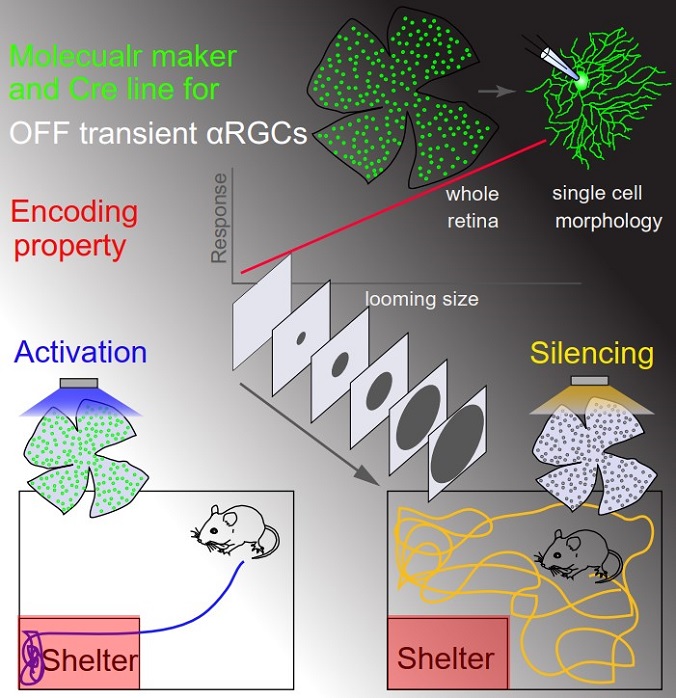Time:2021-04-01
A recent study published in Current Biology demonstrated that there is a labeled line in the mouse retina that mediates looming triggered innate defensive response. This work was performed by researchers in Dr. ZHANG Yifeng’s Lab at the Institute of Neuroscience, Center for Excellence in Brain Science and Intelligence Technology of the Chinese Academy of Sciences. This work has successfully identified a molecular marker for OFF-transient alpha retinal ganglion cells (αRGCs), studied these cells’ response to looming stimuli, and connected their activity to the behavioral output triggered by looming visual stimuli. This study illustrated that as early as in the retina, visual information can be encoded by a labeled line strategy for ecologically significant visual stimuli.
Our visual system not only helps us perceive the outside world but also participates in other tasks fundamental for animal’s well-being, such as the regulation of circadian rhythms, modulation of emotional states, and visually evoked innate behaviors. Some visually evoked innate behaviors require the processing of patterned visual inputs, the same as in the normal visual perception process. Do they use the same coding strategy to encode visual information? The combinatorial coding strategy is employed in forming visual perception. This strategy encodes complex visual information with precision. Labeled line strategy of coding, on the other hand, sacrifices precision for speed, so that signals that are important for animal’s survival can evoke quick responses. Can a labeled line strategy encode visual inputs with sufficient specificity to mediate visually evoked innate behaviors? Or is a combinatorial strategy required?
ZHANG’s team chose to answer this question using looming evoked innate defensive responses as the behavior paradigm. When a mouse sees an expanding dark disk in their upper visual field, which simulates a fast-approaching dark object, it freezes on spot, or quickly escapes to shelter. A subcortical pathway is known to mediate this response, but its origin, which must be in the retina, was unidentified. The research team aimed to identify the retinal origin of this pathway, and study how it encodes the looming stimulus.
Alpha RGCs have long been suspected to be this origin: They have large dendritic arbors to monitor a relatively large visual field, and myelinated axons to transmit signals to the brain quickly. Their morphology and functions are conserved across species, suggesting that they perform some fundamental tasks. However, up until now, there have been no proof of αRGCs’ participation. This was mostly due to a lack of tools: researchers were unable to study the role of αRGCs in this innate defensive response by singling them out, and then specifically manipulating their activities.
The team discovered a specific molecular marker (Kcnip2) for a subtype of αRGCs, the OFF-transient αRGCs. They then constructed a Kcnip2-CreER knock-in mouse. With this mouse line, they could then fluorescently label these cells for targeted recording and morphological studies, and optogenetically or chemogenetically manipulate their activities to study their roles in innate defensive behaviors. They found that OFF-transient αRGCs responded to the looming visual stimuli strongly and encoded the size of the looming object. Ablation or activity suppression of these RGCs abolished the stereotypical behavioral response of mice to a looming stimulus, whereas activation of them triggered immediate escape or freezing behaviors in the absence of a looming stimulus.
In this work, ZHANG’s team link the activity of a single RGC subtype, the OFF-transient αRGCs, to the innate defensive behaviors, demonstrating that they form a labeled line in the mouse retina to encode aversive looming stimuli.
This work entitled “OFF-transient alpha RGCs mediate looming triggered innate defensive response” was published online in Current Biology on April 2, 2021. WANG Fei and colleagues in ZHANG’s lab worked together to finish this work. This work was supported by CAS and NSFC.

Figure legend: A molecular marker for OFF-transient αRGCs was discovered, and a Cre knock-in mouse line was constructed to study these cells (top). These cells encode the size of the looming object (middle). Optogenetic suppression of these RGCs led to diminished escape response to a looming stimulus, and ablation of the cells completely abolished the response (bottom right). In the absence of a looming stimulus, optogenetic activation of OFF-transient αRGCs triggered quick escape-to-shelter behaviors (bottom left). (Image by CEBSIT)
AUTHOR CONTACT:
ZHANG Yifeng
Center for Excellence in Brain Science and Intelligence Technology , Chinese Academy of Sciences, Shanghai, China.
E-mail: zhangyifeng@ion.ac.cn
 附件下载:
附件下载: